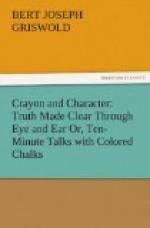The book is planned to encourage the use of sheets of book- or news-paper instead of the blackboard. Paper is used by all leading workers with chalk. To discard the blackboard is to take a forward step. However, if you are “wedded” to the use of the blackboard and can handle it effectively, you will find all but a small number of these illustrations adapted to your method.
Materials Are Cheap.
Probably your school or church is already supplied with the necessary apparatus to do all the work as planned in this book. However, for any who may need to provide for himself a drawing board and easel, instructions for making them are here given. It is only necessary, then, to procure drawing paper and chalk. These are cheap in price and easy to get. You are urged, therefore, to proceed with the use of drawing paper as here instructed, and to lay aside the blackboard for the more advanced method.
Important to Beginners.
Each drawing in the book, as already stated, is given in two “scenes,” in order to show you how your drawing will look when it is partly finished (first scene), and how it will look when it is completed (second scene).
If you are at all “bashful” about taking up the work, let us make this suggestion: In the seclusion of your home or elsewhere, draw the first scene of your talk completely. Thus you will have plenty of time to make it to suit you, with no one to look on and fluster or confuse you. Then cover up the completed work, by placing another sheet of paper over it. When you appear before the audience to give your talk, give your spoken introduction and lead up to the first scene. At this point, remove the cover paper and expose your drawing. Proceed with your talk until you reach the climax in the second scene, at which time you give the picture the final lines with your crayon. Many will find this an easy, satisfactory way to give these talks—indeed many of the illustrations in the book are most effective if given in this way. Experience, however, brings greater confidence, and many will prefer to do most of their drawing in sight of the audience.
Devote yourself to a thorough understanding of essentials, and you will be pleased at the ease with which the field opens. The encouraging words of your associates and the echoes of the good you are doing will strengthen your confidence.
Equipment and Materials.
The necessary equipment and materials for the work include the drawing board, the drawing paper and the chalk (or lecture crayons).
The Drawing Board.
Probably your school has a reversible blackboard mounted on an easel, like that shown in Fig. 1. If so, you will find it amply sufficient for your use. The two or three little holes made by the thumb tacks, to attach your drawing paper to the board, at the top, will not injure it in the least. If you haven’t such a board, it would be well to procure one, as it can be used for many purposes. The writer has often used a board of this kind in giving chalk talks. The publishers of this book will be glad to give full information as to size and price of such a board.




